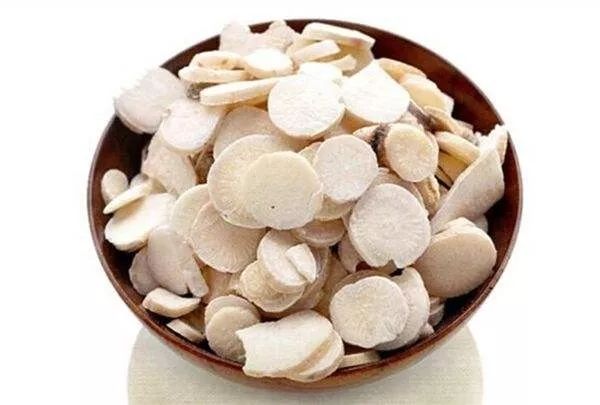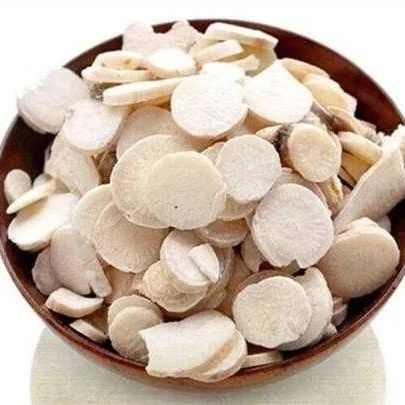
Bai Shao (白芍) possesses various functions such as nourishing blood, astringing yin, softening the liver, alleviating pain, and calming liver yang. It is often paired with many other herbs to form formulas, widely applied in clinical practice across various diseases. Below are five commonly used pairings of Bai Shao with Gui Zhi (桂枝), Chai Hu (柴胡), Gan Cao (甘草), Gui Jia (龟甲), and Dang Gui (当归):
1. Bai Shao and Gui Zhi
Bai Shao nourishes blood and astringes yin, while Gui Zhi is effective in promoting yang, inducing sweating, and relieving muscle tension. Together, they have a complementary relationship that harmonizes the nutritive and defensive qi, as well as a mutually restraining relationship. Bai Shao nourishes yin and astringes sweat, allowing Gui Zhi to induce sweating without harming yin, while Gui Zhi promotes yang, enabling Bai Shao to astringe yin without stagnating the nutritive qi. This pairing forms famous classical formulas such as Gui Zhi Tang (桂枝汤), Gui Zhi Jia Ge Gen Tang (桂枝加葛根汤), and Xiao Jian Zhong Tang (小建中汤), where the dosage ratio of the two herbs is crucial.
Gui Zhi Tang: Used for exterior wind-cold with deficiency of the exterior, where Gui Zhi primarily disperses wind-cold and releases the exterior, while Bai Shao nourishes and astringes yin, with a dosage ratio of 1:1.
Xiao Jian Zhong Tang: Used for abdominal pain due to middle yang deficiency and cold, where Bai Shao combined with Gan Cao (甘草) nourishes yin and alleviates pain, while Gui Zhi warms the channels and promotes yang, with a dosage ratio of 2:1.
Gui Zhi Jia Ge Gen Tang: Used for cervical spondylosis with cold-damp obstruction and pain, where Bai Shao paired with Ge Gen (葛根) primarily alleviates pain, while Gui Zhi warms the channels and disperses cold, with a dosage ratio of 4:1.
2. Bai Shao and Chai Hu
Bai Shao nourishes yin and softens the liver, while Chai Hu promotes liver qi and relieves depression. Together, they work to smooth liver qi and nourish blood, exhibiting a complementary relationship. Bai Shao can prevent Chai Hu from excessively dispersing and damaging liver yin, while Chai Hu can prevent Bai Shao from excessively astringing yin, which could lead to liver qi stagnation. This pairing forms formulas such as Xiao Yao San (逍遥散), Da Chai Hu Tang (大柴胡汤), and Chai Hu Shu Gan San (柴胡疏肝散). In application, the function of the formula can be altered by changing the pairing.
Xiao Yao San: Commonly used for chronic hepatitis and liver cirrhosis, where the main pathogenesis involves liver qi stagnation, spleen deficiency, and blood stasis. Therefore, Bai Shao and Chai Hu are combined with Bai Zhu (白术), Huang Qi (黄芪), and Fu Ling (茯苓) to strengthen the spleen and transform dampness, along with Dang Gui (当归) and Dan Shen (丹参) to resolve stasis and soften masses, achieving the effects of smoothing the liver, strengthening the spleen, and nourishing the liver.
Da Chai Hu Tang: Commonly used for inflammation and infection of the liver and gallbladder, where the pathogenesis involves liver and gallbladder qi stagnation and damp-heat obstruction. Therefore, on the basis of using Chai Hu and Bai Shao to smooth the liver, Da Huang (大黄), Pu Gong Ying (蒲公英), and Jin Qian Cao (金钱草) are added to achieve the effects of smoothing the liver, clearing heat, and detoxifying.
Chai Hu Shu Gan San: Commonly used for chronic gastrointestinal inflammation with liver-stomach disharmony as the main symptom, where the main pathogenesis is liver qi stagnation affecting the spleen and stomach. Treatment should be based on smoothing the liver with Bai Shao and Chai Hu, adding herbs that harmonize the stomach and descend qi, such as Zhi Ke (枳壳), Chen Pi (陈皮), and Xiang Fu (香附).
3. Bai Shao and Gan Cao
Bai Shao and Gan Cao both have strong effects in alleviating pain. Bai Shao is sour, while Gan Cao is sweet; the combination of sour and sweet nourishes yin, thus significantly relieving visceral muscle spasms and pain caused by yin and blood deficiency. This pairing can form formulas such as Shao Yao Gan Cao Tang (芍药甘草汤), Xiao Jian Zhong Tang, and Zhen Ren Yang Zang Tang (真人养脏汤).
Shao Yao Gan Cao Tang: Used for stomach pain due to insufficient yin and blood, such as in atrophic gastritis and peptic ulcers with insufficient gastric juice secretion. When using this formula, attention should be paid to the ratio of Bai Shao to Gan Cao, generally 3:1, and depending on the nature of cold or heat, either honey-fried Gan Cao or raw Gan Cao should be used.
Xiao Jian Zhong Tang: Also utilizes Bai Shao and Gan Cao for their pain-relieving effects, suitable for abdominal pain due to middle yang deficiency and cold, thus adding Gui Zhi to warm the channels and disperse cold, preventing Bai Shao from excessively astringing and harming yang.
Zhen Ren Yang Zang Tang: Used for chronic diarrhea with urgency and abdominal pain, where Bai Shao and Gan Cao alleviate pain. However, in cases of diarrhea due to spleen and kidney yang deficiency, the formula includes Ren Shen (人参), Bai Zhu, and Rou Gui (肉桂) to warm yang and tonify qi, while also using poppy husk and Haritaki (诃子) to bind the intestines and stop diarrhea, with Bai Shao and Gan Cao alleviating pain as a symptomatic treatment, thus the application of Bai Shao and Gan Cao should be based on syndrome differentiation.
4. Bai Shao and Gui Jia
Bai Shao astringes yin and clears heat while softening the liver, and Gui Jia nourishes yin and subdues yang, together they work to astringe yin and subdue yang, softening the liver and extinguishing wind. In cases of yin deficiency with yang hyperactivity, where yin deficiency is the root and yang hyperactivity is the manifestation, Bai Shao nourishes blood and astringes yin to treat the root, while Gui Jia nourishes yin and subdues yang, assisting Bai Shao in nourishing yin and calming the hyperactive yang. Therefore, the relationship between Gui Jia and Bai Shao is one of treating both the root and the manifestation, commonly used in clinical practice for liver and kidney yin deficiency with internal wind disturbance. The causes and mechanisms of yin deficiency with yang hyperactivity are complex, with formulas such as Zhen Gan Xi Feng Tang (镇肝熄风汤), Da Ding Feng Zhu (大定风珠), and Hu Qian Wan (虎潜丸) all centered around Gui Jia and Bai Shao, though their effects differ.
Zhen Gan Xi Feng Tang: Used for liver and kidney yin deficiency, wind yang hyperactivity, and qi and blood disturbance, thus combining Zhi Shi (制石), Sheng Long Gu (生龙骨), and Sheng Mu Li (生牡蛎) with Gui Jia to enhance the ability to calm the liver and subdue yang, suitable for various stroke symptoms.
Da Ding Feng Zhu: Used for warm disease with heat evil lingering, burning the true yin, and internal movement of empty fire, leading to malnourishment of the tendons and movement of wind. Its main function is to nourish fluids and extinguish wind, thus on the basis of using Gui Jia and Bie Jia (鳖甲) to subdue yang and extinguish wind, it heavily incorporates E Jiao (阿胶), Sheng Di Huang (生地黄), Huo Ma Ren (火麻仁), Wu Wei Zi (五味子), Mai Dong (麦冬), and Ji Zi Huang (鸡子黄) with Bai Shao to nourish yin, replenish fluids, and moisten the tendons to achieve the effect of nourishing fluids and extinguishing wind.
Hu Qian Wan: Used for liver and kidney yin deficiency leading to atrophy syndrome. On the basis of using Zhi Mu (知母), Huang Bai (黄柏), and Shu Di Huang (熟地黄) with Bai Shao to nourish yin and clear fire, it incorporates Hu Gu (虎骨) and Suo Yang (锁阳) with Gui Jia to tonify the kidneys, replenish essence, and strengthen the tendons and bones, treating atrophy syndrome caused by liver and kidney yin deficiency.
5. Bai Shao and Dang Gui
Bai Shao and Dang Gui both have blood-nourishing, liver-softening, and pain-relieving effects. Their combination can be described as a mutually supportive relationship. However, the pairing of Bai Shao and Dang Gui also exhibits a complementary relationship with opposing effects. Bai Shao nourishes yin, while Dang Gui nourishes blood, thus together they replenish both yin and blood. Additionally, Bai Shao is static and primarily guards, while Dang Gui is dynamic and primarily moves, nourishing blood and astringing yin to prevent blood stagnation, while promoting blood circulation without excessively moving blood and harming yin. The combination of these two herbs compensates for each other’s weaknesses, achieving a synergistic effect. Due to the prominent cold, sour, and astringent properties of Bai Shao, formulas that pair Bai Shao and Dang Gui, such as Xiao Yao San, Shao Yao Tang (芍药汤), and Wen Jing Tang (温经汤), benefit significantly from Dang Gui’s warming and blood-moving properties, which greatly enhance their overall efficacy.
Xiao Yao San: Utilizes Chai Hu and Bai Shao to soothe the liver and relieve depression, while Dang Gui’s blood-nourishing properties can treat liver depression leading to yin and blood depletion, and its blood-activating properties can treat blood stasis caused by liver qi stagnation.
Shao Yao Tang: Uses Bai Shao as the monarch to harmonize qi and blood to treat diarrhea, with abdominal pain and heaviness, while Dang Gui nourishes and moves blood, allowing for the expulsion of pus and blood in the stool.
Wen Jing Tang: Warms the channels, disperses cold, nourishes blood, and resolves stasis. Bai Shao can nourish blood and cultivate yin, but its cold, sour, and astringent nature is evidently unfavorable for treating deficiency-cold conditions, thus adding Dang Gui to warm and activate blood, compensating for Bai Shao’s weaknesses and achieving a synergistic effect.
This article is excerpted from the Journal of Traditional Chinese Medicine, July 2002, Author: Ren Guanglai, Edited by: Ren Siwei
If there are any inappropriate uses, please contact for removal.
Reminder: Due to individual differences in physical conditions, the formulas provided in this article should be adjusted based on syndrome differentiation, and it is recommended to seek guidance from a professional doctor.

Scan to follow me



